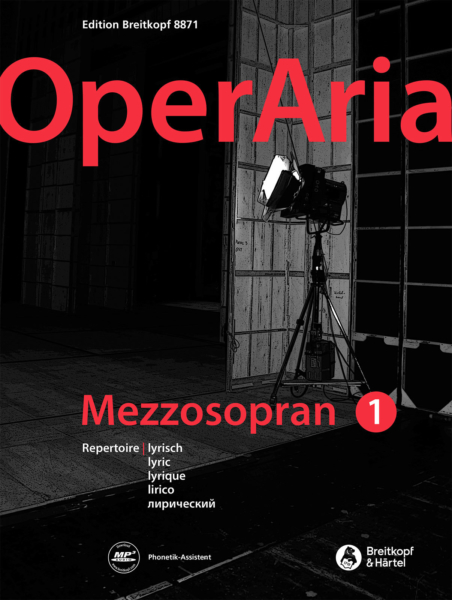OperAria Mezzosopran
Repertoiresammlung herausgegeben von Peter Anton Ling und Marina Sandel [Mez,Klav]
„Es ist eine der schwierigsten Entscheidungen für Sänger (und ihre Lehrer!), das im Moment passende Repertoire auszuwählen. Die drei Bände für Mezzosopran und Alt sind dafür eine hervorragende Orientierungshilfe – und ein großes Geschenk!“ (Marilyn Schmiege, Schirmherrin Mezzosopran, Alt)
Nachdem Sie die gewünschten Ausgaben in den Warenkorb gelegt haben, können Sie dort die benötigte Stückzahl bei Bedarf noch anpassen.
„Unser Anliegen ist es, Studierenden einen modernen, systematisch aufgebauten, gut informierten VokalCoach an die Hand zu geben, der den Anforderungen der heutigen Theaterpraxis entspricht. Endlich ein stimmiges Repertoire und eine schlüssige Bündelung der Vorsingearien für jede Stimmgattung.“ (Peter Anton Ling, Herausgeber)
OperAria ist eine umfassende RepertoireSammlung von Opernarien für alle Stimmgattungen von Sopran bis Bass. Sie wurde hauptsächlich für die Gesangs-Ausbildung und das Theatervorsingen entwickelt, richtet sich jedoch auch an bereits beruflich tätige Sänger und Gesangspädagogen.
Die Auswahl der Arien aus drei Jahrhunderten klassischen Opernrepertoires erfolgte nach stimmlichen Kriterien und unter Berücksichtigung musikalischer und theaterpraktischer Aspekte. Sie liefert zudem wertvolle Anregungen für Opern-Recitals.
Die Einteilung der Arien in die Kategorien lyrisch, lyrisch-dramatisch und dramatisch dient als Orientierungshilfe, lässt jedoch genügend Spielraum für die Individualität der verschiedenen Stimm- und Rollentypen.
Das entscheidende Plus von OperAria gegenüber vergleichbaren Repertoiresammlungen besteht in seiner zusätzlichen Funktion als gut informierter VokalCoach. Folgende Extras sind darin eingeschlossen:
- Ausführlicher Kommentarteil
Alle Bände bieten in den Einzelkommentaren zu jeder Arie Informationen u. a. zu Komponist, Werk, Fassungs- oder Besetzungsfragen einschließlich einer kurzen, inhaltlichen Zusammenfassung, welche die Arie in den Handlungskontext der Oper stellt. Hinzu kommen methodische Hinweise aus sängerischer Sicht als Empfehlung aus der Praxis. - Phonetik-Assistent
Als weitere Studierhilfe stehen Audiodateien (mp3) mit Arientexten gesprochen von Muttersprachlern bereit. - Text-Assistent
Für ein gründlicheres Verständnis der Arieninhalte sorgt der Text-Assistent mit Textdateien (pdf) in deutscher und englischer Übersetzung.
Sowohl der Phonetik- als auch der Text-Assistent sind als Download unter www.breitkopf.com verfügbar.
Woraus besteht eine Stimme? Natürlich aus Knorpel, Muskeln, Bändern und Epithel; aber auch aus der Persönlichkeit, den Interessen, Vorlieben und Charakterzügen, die das Einmalige eines jeden Menschen ausmachen.
Jeder Mensch ist ein Individuum. So, wie es nicht nur Schuhgröße 36 und 38, sondern auch 37½ gibt, so gibt es auch bei Stimmen viele Zwischengrößen, sowie innerhalb jeder Stimmgattung viele Schattierungen und Facetten. Jede Rolle verlangt einen passenden Körperbau, die notwendige Kraft und Flexibilität (sowohl im Kehlkopf als auch im Atmungsapparat) und die angemessene psychische Affinität und Vorstellungskraft, um zufriedenstellend und letztendlich erfolgreich gesungen und auf der Bühne glaubhaft durchgelebt zu werden.
Es ist eine der schwierigsten Entscheidungen für Sänger (und ihre Lehrer!), das im Moment passende Repertoire auszuwählen: Wo stehe ich jetzt? Wo könnte ich demnächst vielleicht hineinwachsen? Wovon sollte ich im Moment lieber die Finger lassen? Die drei Bände für Mezzosopran und Alt sind dafür eine hervorragende Orientierungshilfe – und ein großes Geschenk!
Die Experten, die diese Auswahl getroffen und geordnet haben, sind erfahrene Sänger und Pädagogen. Sie haben nicht nur Umfang und Tessitura der jeweiligen Arien, sondern auch stilistische, musikalische und praktische Fragen bedacht, wie Orchesterbesetzung, Entstehungszeit der Oper, Theatergröße, Aufführungspraxis und nicht zuletzt den Theater- und Agenturalltag.
Selbstverständlich ist auch dieser Versuch, Opernarien einzuordnen, nicht endgültig oder gar universell anwendbar. Es wird immer Sängerinnen geben, die „den Rahmen sprengen“ und die körperliche und psychische Flexibilität besitzen, gleich mehrere Fächer gut bedienen zu können. Doch ein Blick über den Tellerrand – ab und zu ein paar Takte Wagner zum Beispiel – kann für jede Sängerin, wenn klug gemacht, sogar gesund sein und zum Nachdenken anregen.
Ich freue mich, in diesen gut sortierten Alben Wohlbekanntes, aber auch neue, bisher mir unbekannte Arien zu finden. Ich bin überzeugt, Ihnen wird es auch so ergehen, und wünsche viel Freude auf der Entdeckungsreise in den Alben – und in sich!
Marilyn Schmiege, München, Frühjahr 2020
Wer kennt sie nicht als treue Wegbegleiter: die traditionellen Arienalben – manchmal auch nur mühsam daraus zusammengestellte fliegende Blätter – mit einem oft schlecht spiel- oder lesbaren, nicht immer zuverlässigen Notentext. Sie gehörten einfach dazu, leisteten gute Dienste und ersparten aufwendiges Recherchieren in Bibliotheken, auch wenn viele der abgedruckten Arien nicht zur eigenen Stimme passten, sei es, weil das Repertoire zu unterschiedlich zusammengestellt war und lediglich die Einteilung in Stimmlagen berücksichtigte, sei es, weil ambitionierte Herausgeber Partien in einem Band vereinten, die unter sängerischen Gesichtspunkten nicht von ein und derselben Person zu bewältigen sind. Auch die inzwischen weitaus bequemeren Möglichkeiten des Internets boten bislang keine überzeugende Alternative.
Anliegen der vorliegenden Repertoiresammlung mit Opernarien ist es, dem Benutzer einen modernen Wegbegleiter oder – um im Bild zu bleiben – einen systematisch aufgebauten, gut informierten Vokalcoach an die Hand zu geben, der sich auf der Höhe der Zeit bewegt und den Anforderungen der heutigen Theaterpraxis entspricht. Hauptsächlich zum Gebrauch für Hochschulstudien und Theatervorsingen entwickelt, richtet sich die Repertoiresammlung jedoch nicht nur an Studierende, sondern auch an bereits beruflich tätige Sänger, die ihr Fachrepertoire erweitern möchten oder sich auf einen Fachwechsel vorbereiten. Darüber hinaus dürfte eine schlüssige Bündelung des Vorsingrepertoires, wie sie hier vorgestellt wird, auch für gesangspädagogisch Tätige und alle diejenigen interessant sein, die sich unter dem Aspekt spezifischer Stimmprofile über Besetzungsfragen informieren möchten oder die bei Rollenbesetzungen an Theatern mitzuentscheiden haben.
Der vorliegende Band enthält einen repräsentativen Querschnitt durch das lyrische Mezzosopran-Repertoire und ist Bestandteil einer umfassenden Repertoiresammlung von Opernarien für alle Stimmgattungen. Die grundlegende Einteilung in die Kategorien lyrisch, lyrisch–dramatisch und dramatisch ist als Orientierungshilfe sinnvoll; sie gibt eine Richtung vor, lässt aber genügend Spielraum für die Individualität der verschiedenen Stimm- und Rollentypen und wird deshalb unter Lehrenden wie Theaterpraktikern zunehmend als nützliche Ergänzung zur traditionellen Stimmfacheinteilung verwendet, ohne mit dieser konkurrieren zu wollen. Überschneidungen zwischen den Kategorien und dem jeweils in den Einzelbänden enthaltenen Repertoire lassen sich bei einer so offenen Einteilung wie der hier vorgenommenen natürlich nicht ganz ausschließen.
Die Auswahl der Arien aus drei Jahrhunderten des klassischen Opernrepertoires erfolgte nach stimmlichen Kriterien (Umfang, Tessitura, Spezifika, Arientyp) unter Berücksichtigung musikalischer und theaterpraktischer Aspekte (Stilistik, Epoche, Rollentyp, nationale Herkunft). Arien aus Barockopern, die heute zwar ebenfalls zum gängigen Repertoire gehören, aber teils andere Fähigkeiten und weitere Kenntnisse erfordern, wurden in der Regel dabei nicht.
Meist, aber nicht immer, deckt sich der Grundcharakter der ausgesuchten Arien mit demjenigen der gesamten Partie. In Fällen, wo die stimmlichen Anforderungen von Einzelarie und Gesamtpartie auseinanderklaffen, wird darauf eigens hingewiesen, um der Gefahr stimmlicher Überforderung vorzubeugen. Ausgewählt wurden sowohl gängige Vorsingarien als auch schwer oder nur in unzulänglichen Ausgaben zugängliche Raritäten sowie Arien der klassischen Moderne des 20. Jahrhunderts, die zumeist aus urheberrechtlichen Gründen in traditionellen Arienalben fehlen, inzwischen aber Eingang in die Spielpläne gefunden haben. Damit enthält diese Repertoiresammlung neben den unverzichtbaren klassischen Vorsingarien für Theatervorsingen eine breit gefächerte Auswahl an Arien für Vortragsabende, Konzerte, Opern-Recitals, mit der Studierende wie Ausübende ihre stimmlichen und gestalterischen Fähigkeiten zeigen können.
Der Notentext der Arien basiert auf Ausgaben, die in der Bühnenpraxis als Standard gelten und die größte textliche Zuverlässigkeit bieten. Die Klaviersätze wurden entweder neu erarbeitet oder auf der Grundlage bewährter Klavierauszüge mit dem Ziel revidiert, eine partiturnahe klangliche Realisierung bei möglichst einfacher Spielbarkeit zu ermöglichen. Gelegentlich mussten Arien gekürzt (z. B. orchestrale Vor- oder Zwischenspiele) oder praktikable Schlüsse ergänzt werden (z. B. in weiterführenden, offenen Arien und Szenen).
Die Einzelkommentare zu den Arien enthalten Informationen zu Komponist, Librettist, Werk, Tonumfang und zu eventuellen Besonderheiten wie Fassungs- oder Besetzungsfragen einschließlich einer kurzen Inhaltsangabe, die die dramatische Grundkonstellation andeutet, in der die jeweilige Arie im Handlungskontext der Oper steht. Hinzu kommen methodische Hinweise aus sängerischer Sicht als Empfehlung aus der Praxis von Bühne und Hochschule, in die wertvolle Ratschläge vieler Sängerkolleginnen und -kollegen eingeflossen sind. Schließlich sei auf zwei Studierhilfen für die Arientexte verwiesen: einen „Phonetik-Assistenten“ mit Audiodateien (mp3) in der Originalsprache, von Muttersprachlern gesprochen, und einen „Text-Assistenten“ mit Textdateien (pdf) in deutscher und englischer Übersetzung. Beide sind als Download unter www.breitkopf.com verfügbar.
Dem Bund Deutscher Gesangspädagogen und einer Reihe von Lehrenden der Hochschule für Musik, Theater und Medien Hannover sei ganz herzlich für fachlichen Austausch und kollegialen Rat gedankt. Besonderer Dank gilt meiner Kollegin Marina Sandel, die mit ihrem reichen Erfahrungsschatz beim Verfassen der methodischen Hinweise und bei der Auswahl der Arien wesentlich zum Gelingen der Ausgabe beigetragen hat. Zu danken ist auch dem Tonmeister Dirk Austen und den Mitwirkenden an der Audio-Aufnahme sowie allen, die beim Übersetzen und Korrekturlesen halfen: Eleanor Forbes, Petra Kamlot und Isabel Sievers (englisch), Jutta Eckes (italienisch), Sabine Wehr-Zeller (französisch), Diane Ackermann für die dramaturgische Mitarbeit, Christian Beyer für die Revision der Klavierauszüge, Christian Rudolf Riedel für das genaue, sachkundige Lektorat und sein unermüdliches Engagement bei der Koordinierung aller am Gelingen der Ausgabe Beteiligten und schließlich dem Verlag Breitkopf & Härtel, der die Ausgabe erst möglich gemacht hat.
Peter Anton Ling, Hannover, Frühjahr 2020










 Blättern
Blättern


